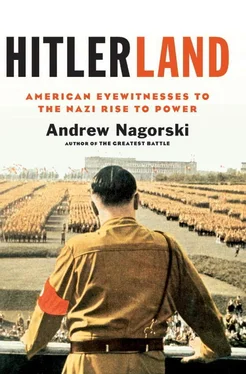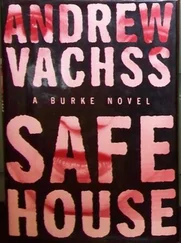Thompson sent another letter to a friend in London, the pianist Harriet Cohen, who knew British Prime Minister Ramsay MacDonald. She explained that she had seen many victims of Nazi violence with her own eyes. The SA thugs had gone “perfectly mad” as they hunted down new victims, she wrote. “They beat them with steel rods, knock their teeth out with revolver butts, break their arms… urinate on them, make them kneel and kiss the Hakenkreuz [the swastika].” Noting the silence of the German press and the exodus of such writers as Thomas Mann, Erich Maria Remarque and Bertolt Brecht, she let loose with her frustration. “I keep thinking what could be done… I feel myself starting to hate Germany. And already the world is rotten with hatred. If only someone would speak…” Cohen understood this to be an appeal for her to show the letter to MacDonald, which she did.
Not that such messages had any impact. The Nazis continued to usher in their new order with new drama. On the evening of May 10, propaganda chief Joseph Goebbels presided over the infamous “burning of the books”—“the auto da fé of ‘un-German literature,’” as Knickerbocker described it, “when throughout the Reich 100,000 students gathered to destroy ‘Jewish, Marxist, anti-German, immoral’ publications of 280 authors, many of them bearing world-famous names.” It was “a circus of historical significance but one that furnished immense entertainment for the participants.”
Addressing the crowd, Goebbels declared: “These flames do not only illuminate the final act of the old era, they also light up the new. Never before have the young men had so good a right to clean up the debris of the past… Oh, my century, it is a joy to be alive.” Along with the predictable volumes of Marx, Engels and Lenin, books by Remarque, Brecht, Hemingway and even Helen Keller ( How I Became a Socialist ) went up in flames, all part of an estimated total of 20,000 copies incinerated that night while the crowd cheered and sang.
Several correspondents witnessed the spectacle, and the cumulative effect of the Nazi actions was a growing sense of repulsion among many of them. Even the Baltimore Sun ’s Bouton, whom Lochner had scornfully referred to as “an ardent Nazi” earlier, underwent a fundamental transformation and started filing increasingly hard-hitting stories, warning “that the truth [about the Nazis’ tactics] is ten times worse than the reports.” Just over a year after Hitler took power, the German Foreign Ministry ordered Bouton to “change his style of reporting or leave the country.” Within a short time, he was gone.
Most of Bouton’s colleagues, including Lochner, very much wanted to keep covering what was the most exciting story of the moment. Besides, their home offices didn’t want dramatic exits—they wanted to keep their reporters in Berlin. “Our orders from our bosses were to tell no untruth, but to report only as much of the truth, without distorting the picture, as would enable us to remain at our posts,” Lochner wrote in his memoirs. Cautious by nature, the AP veteran would follow those instructions.
Other Americans exhibited even greater caution, but sometimes for other reasons. Despite all the violence and intimidation—in fact, directly because of the seemingly unbridled nature of the almost daily attacks on anyone deemed a political opponent—the outsiders were often puzzled and still suspended judgment on what exactly was driving this fury.
Writing in the American Federationist , the house organ of the American Federation of Labor, Abraham Plotkin summed up the desperate situation of his German counterparts in an article that he published shortly after his return to the United States in May 1933. “The Nazis have turned loose forces that they themselves do not understand,” the Jewish-American labor organizer insisted. “It may surprise many to learn that the most exciting things that have happened in Germany have come as an upsurge from below, and not from the government itself.” Citing as an example the anti-Jewish boycott in Munich, which was formally disavowed by Hitler’s government, he claimed it had been started by SA troops and “it gained such momentum within a few hours that not one among the Nazi leaders dared to make an effort to head it off.”
Plotkin was far from the only American subscriber to the notion that Hitler and other top Nazis were seeking to restrain their supporters rather than incite them to ever greater violence. Consul General Messersmith initially believed that Hitler had to ride the violent wave of his followers since otherwise he might be replaced by “real radicals.” Growing protests back in the United States, such as the one held in Madison Square Garden on March 27, were only whipping up “what was almost hysteria” among those German leaders who wanted to pursue a moderate course, he warned. Unlike Plotkin, he believed that the subsequent boycott of Jewish businesses in Germany had been ordered from the top, but to contain the popular resentment and control it. When the government officially abandoned the boycott on April 4, he was pleased to report that the number of anti-Semitic incidents dropped quickly.
Not even the fact that a growing number of Americans were caught up in the violence could shake Messersmith’s belief that the reality of what was happening was far more complicated than it appeared—and that it would be counterproductive to pin all the blame on Hitler. In early March, Nathaniel Wolff, a painter from Rochester, New York, was nabbed by the SA when he was overheard denouncing both Communists and Nazis. Before he was allowed to leave the country, he had to sign a statement promising that he would never return. “I am a Jew,” it read. “I certify that no physical violence has been done to me and none of my property has been stolen.”
Others were not so lucky. Some, like editor Edward Dahlberg, a visiting Scribner’s Magazine editor, were beaten on the street. The American wife of a German Jew had to watch storm troopers, who had burst into their apartment, beat her husband, ostensibly for having four suits in their closet. “Four suits, while for fourteen years we have been starving,” one of his tormenters shouted. “Jews. We hate you.”
On March 31, the SA snatched three Americans and took them to a makeshift prison, where they were stripped and left to sleep on the cold floor. The next day, their tormentors beat them unconscious before leaving them out on the street. American correspondents knew of this and other incidents, but Messersmith convinced them to hold off any reporting on what happened to the trio of Americans on March 31 for forty-eight hours. He explained this would allow him to press the authorities to take the proper actions first. As Messersmith reported with evident satisfaction, the police took “rapid action” and the guilty Brownshirts were “sharply reproved” and expelled from the ranks.
Messersmith and other embassy officials kept protesting when Americans were assaulted, as they continued to be. But they also looked for signs of hope in any case where the authorities seemed willing to help. During the summer of 1933, America’s famous radio broadcaster H. V. Kaltenborn returned to Berlin for a visit with his son Rolf. He told Messersmith that American reporters like Mowrer were surely exaggerating in their stories about incidents of Nazi brutality. A few days later when his son Rolf failed to salute the Nazi banners carried in one of the frequent parades, a storm trooper hit him. Learning of the incident, the Propaganda Ministry promptly issued his father a written apology “in the hope that I would not feature my son’s misadventure in a broadcast,” Kaltenborn recalled. He added, “I had, of course, no intention of exploiting a personal experience.”
Читать дальше











